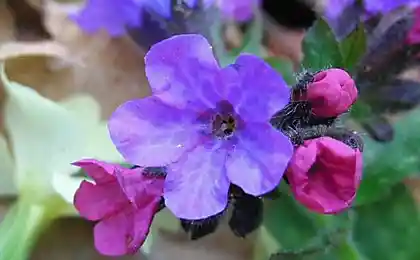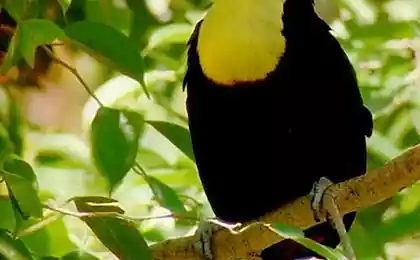529
Lungwort: from pink to blue
Fifty three million six hundred eighty nine thousand four hundred thirty four
Every spring the beautiful pulmonaria pleases our eyes two or three bright shades.
It blooms on the first one. It does not argue with such stars of the spring garden as tulips or daffodils, and gracefully accompanies the soloists. When the bees fades, the fore intricately painted leaves:
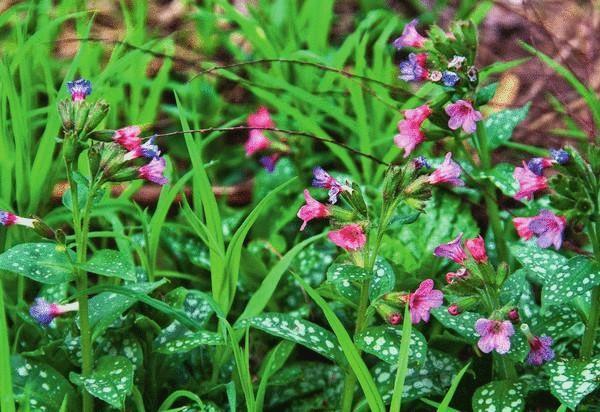
The name lungwort in Russian and many other Slavic languages (medonic, Madonna, medunka, medunac and medownick) come from the word "honey". This is not surprising because the portion of nectar in the tube of the flower Corolla is actually quite large. A couple flowering bushes will attract to your garden the cheerful humming of bees, mellifluous after the winter silence. Certainly look at medunic and beautiful spring butterflies. This will most likely be blindingly bright limonite or a more modest coloring dawn.
Lungwort is a perennial rhizomatous plant of small height, forming clumps of large oblong basal leaves on long stalks, often with a mottled pattern. Flowers in paired tendrils at the tips of stems and bloom in spring or early summer. Natural species the Corolla diameter of 8-15 mm in grades up to 20 mm. Flowering lasts about a month.
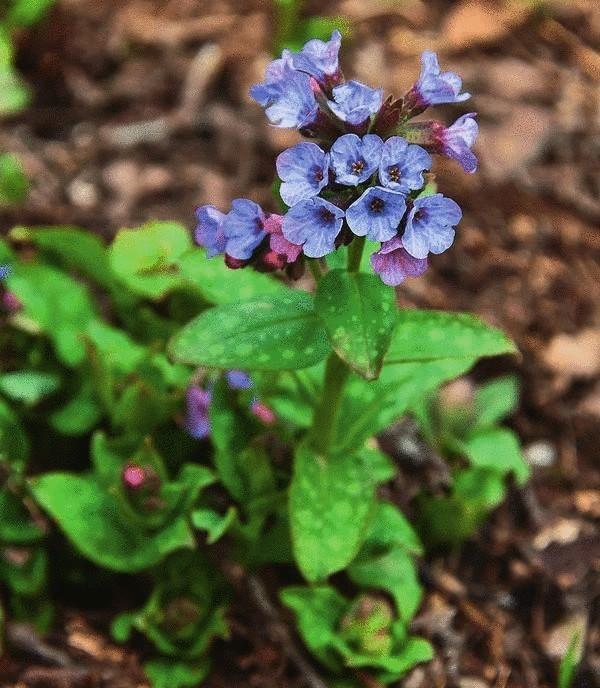
Buds and just-opened flowers of pulmonaria officinalis, and like her species is painted inpink and red colors. A few days later the flower becomes purple hue, and finally blue.

Three shades on the same Bush are common lungwort. Nature is rich in options. So there may be other chain reactions, such as light pink — pale blue — white. There is lungwort, which is valued for its persistent red color. It is called lungwort red. There are natural types of mainly blue color. Experts say, for example, that the best blue varieties are derived from narrow-leaved lungwort. In English, she eloquently called blue Primula, and its garden form Azurea — azure primrose. This color dynamics have the most varieties, while the quantitative ratio of the shades that the eye perceives a particular sort of as pink, purple or blue.
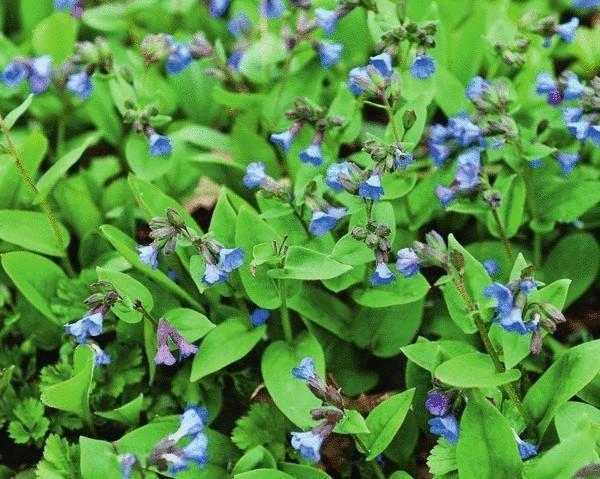
For us in the nuances of color special beauty of flower, but remove any use of its polychromy, the plant itself? Environmentalists believe that the bees "tries" for insect pollinators. It marks red fresh flowers, full of nectar. In old flowers the nectar dries up, and explaining signal is blue. It is established that bees and bumblebees primarily fly it on red and pink flowers of the lungwort. It would seem that the blue halos would have to fall to the ground. But the plant still keeps them on the Bush, the more and brighter the color the stain, the better visible to the bees from a distance, and so the more pollinators it will attract.
Near there is another mechanism that allows insects to not waste time on empty troubles. Why try so hard? Very simple: in the vast thickets of the bee bees don't linger on one Bush that the plant is equivalent to self-pollination, and in finding the red flowers will go further, thereby ensuring the transfer of pollen over longer distances. For bees with its two types of flowers, preventing self-pollination is especially important. Well, in early spring, while blooming flowers is not enough, the bee, of course, will try everything more than once... Repetition is the mother of learning.
The color of the flower affect not the visits of insects, and the changing chemistry of the cell SAP. In Bud it is acidic, in opened flowers — neutral, later alkaline. In response to the changing acidity of the medium is rapidly changing the hue of anthocyanins dissolved in the juice of dyes, known for this feature plant chameleons. They also repainted the red buds in Magenta, purple and blue beads.
The conversation will nechistoplotnym about the shortcomings of the plants. They, fortunately, quite a bit: this low-maintenance plants there are practically no weak points.
Powdery mildew affects mainly old varieties of pulmonaria officinalis. You can see side by side, absolutely healthy and covered with dew courtines. Evaluate critically whether you can keep them. If sick plants, does not represent special value, feel free to leave them and find a replacement. Many of the new selection have better health.
If for any reason you wish to lose an old favorite variety, here are a few tips on how to deal with the scourge:
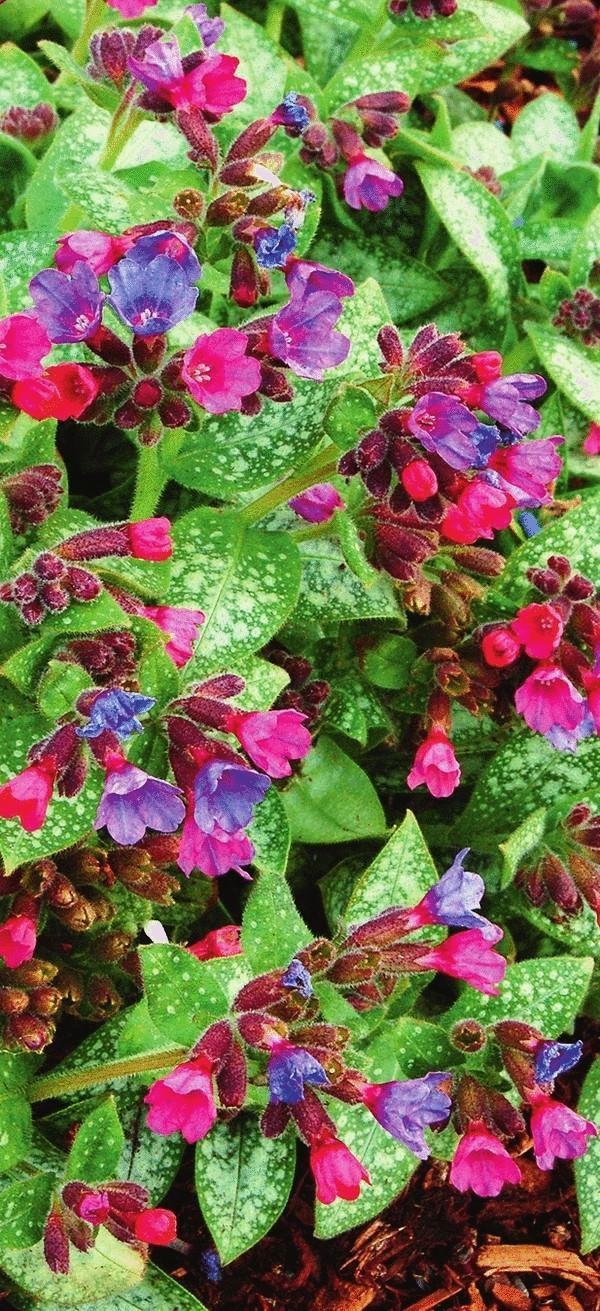
The nuances ofencouragement natural diversity and the work of breeders there were many beautiful varieties. This lungwort, considerably surpassing the wild plants of brightness and abundance of flowering, and dekorativnolistnye varieties truly great beauty to our latitude. Both directions of breeding of magically incorporate the innovations of the last decades.
The leaves of some lungwort bold coloring resemble the bright attire of the inhabitants of the tropical greenhouses begonias, dieffenbachia or aglaonema. They primarily attract those who are to save energy selects plants that are interesting throughout the season. But if dekorativnolistnye varieties in addition to impressive bloom — good luck double. Words, alas, give only a General idea of the varieties. Get at least a silver "splash" on the leaves! In this formula the many nuances!
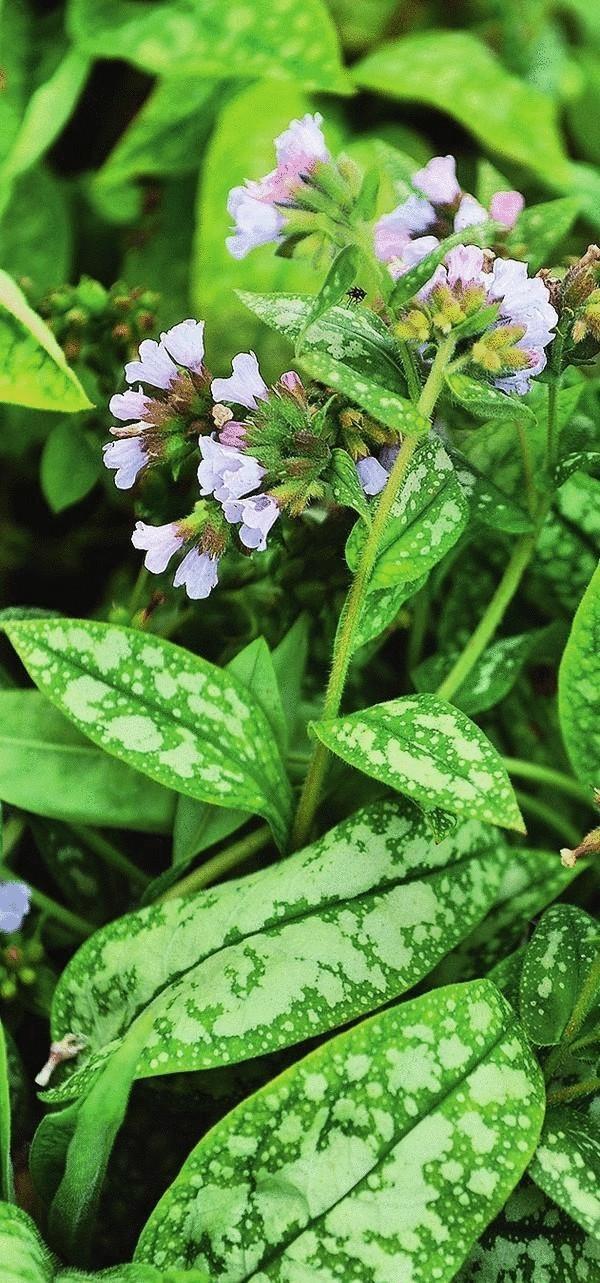
Spots can be large and small, light green and dark background. They can almost merge with each other, moving in a solid silver-tone, having a marble pattern or remind a scattering of pearls and stars in the night sky. Great contrast of silver and dark green color in the edging of the leaves.
To visualize the description of varietal differences in flower color is also not easy. Even the photograph is not entirely transparent, as it reflects only a moment, while at different stages of blooming flowers the shades. In addition, the appearance of bees depends largely on the climate and local conditions. Another unpleasant detail is the presence on the market of unfair propagated by seed plants that do not retain signs of the original varieties.
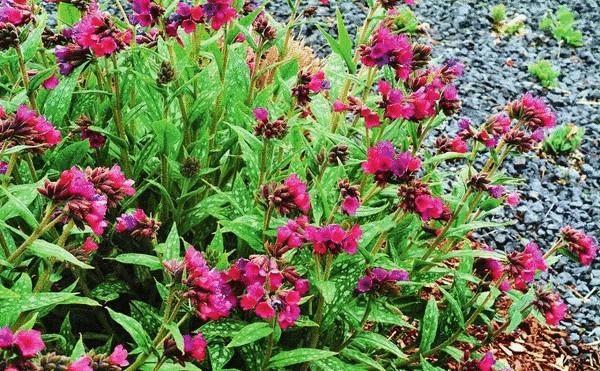
The most popular varieties of bees about three dozen. Among them are grade-centenarians, and the trends of the last decades.
Lungwort is included in the scope of their interests nursery Terra Nova (USA), famous for the impressive contribution to the expansion of the range of ornamental perennials. Since the 90-ies of the last century, he brought to the arena for more than 20 new products, representing a kind of lungwort. Special efforts were aimed at overcoming the shortcomings of the old varieties. In the end, lungwort Terra Nova has high resistance to powdery mildew and preservation of high decoration of leaves throughout the season.
Fit and rhodogune prefer partial shade and loose, moderately moist soil, rich in humus. When planting it is useful to make compost.
M. angustifolia grows well on sandy soils. Dry weather is desirable watering. Plants are responsive to the feedings. A good way to maintain soil fertility — annually to mulch the ground around the bushes with humus. Do this immediately after planting, after pruning of old leaves and stems before winter.
Fertilizing with a solution of complete fertilizer is to be paid at the beginning of the regrowth of new leaves.
Overgrown bushes divide every 4-5 years after flowering in July or August or in the spring.
Lungwort hardiness, but hybrids with the participation of thermophilic species, such as M. vlavianos, it is desirable to cover winter or dry leaves to insulate the roots in leaf humus or peat.
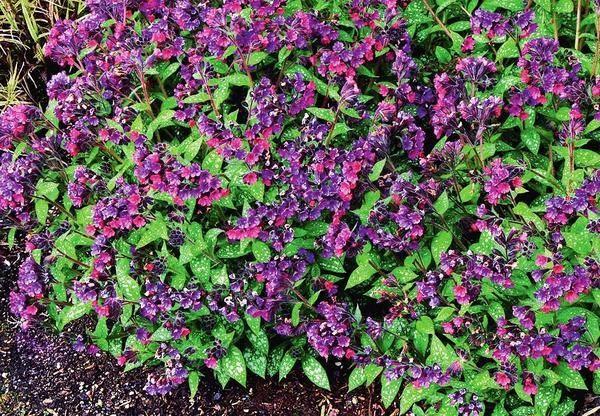
In gratitude, the bees will grant you a lush and bright blooms, and the variability of its coloration will not let you get bored! published
P. S. And remember, only by changing their consumption — together we change the world! ©
Source: www.7dach.ru
Every spring the beautiful pulmonaria pleases our eyes two or three bright shades.
It blooms on the first one. It does not argue with such stars of the spring garden as tulips or daffodils, and gracefully accompanies the soloists. When the bees fades, the fore intricately painted leaves:

The name lungwort in Russian and many other Slavic languages (medonic, Madonna, medunka, medunac and medownick) come from the word "honey". This is not surprising because the portion of nectar in the tube of the flower Corolla is actually quite large. A couple flowering bushes will attract to your garden the cheerful humming of bees, mellifluous after the winter silence. Certainly look at medunic and beautiful spring butterflies. This will most likely be blindingly bright limonite or a more modest coloring dawn.
Lungwort is a perennial rhizomatous plant of small height, forming clumps of large oblong basal leaves on long stalks, often with a mottled pattern. Flowers in paired tendrils at the tips of stems and bloom in spring or early summer. Natural species the Corolla diameter of 8-15 mm in grades up to 20 mm. Flowering lasts about a month.

Buds and just-opened flowers of pulmonaria officinalis, and like her species is painted inpink and red colors. A few days later the flower becomes purple hue, and finally blue.

Three shades on the same Bush are common lungwort. Nature is rich in options. So there may be other chain reactions, such as light pink — pale blue — white. There is lungwort, which is valued for its persistent red color. It is called lungwort red. There are natural types of mainly blue color. Experts say, for example, that the best blue varieties are derived from narrow-leaved lungwort. In English, she eloquently called blue Primula, and its garden form Azurea — azure primrose. This color dynamics have the most varieties, while the quantitative ratio of the shades that the eye perceives a particular sort of as pink, purple or blue.

For us in the nuances of color special beauty of flower, but remove any use of its polychromy, the plant itself? Environmentalists believe that the bees "tries" for insect pollinators. It marks red fresh flowers, full of nectar. In old flowers the nectar dries up, and explaining signal is blue. It is established that bees and bumblebees primarily fly it on red and pink flowers of the lungwort. It would seem that the blue halos would have to fall to the ground. But the plant still keeps them on the Bush, the more and brighter the color the stain, the better visible to the bees from a distance, and so the more pollinators it will attract.
Near there is another mechanism that allows insects to not waste time on empty troubles. Why try so hard? Very simple: in the vast thickets of the bee bees don't linger on one Bush that the plant is equivalent to self-pollination, and in finding the red flowers will go further, thereby ensuring the transfer of pollen over longer distances. For bees with its two types of flowers, preventing self-pollination is especially important. Well, in early spring, while blooming flowers is not enough, the bee, of course, will try everything more than once... Repetition is the mother of learning.
The color of the flower affect not the visits of insects, and the changing chemistry of the cell SAP. In Bud it is acidic, in opened flowers — neutral, later alkaline. In response to the changing acidity of the medium is rapidly changing the hue of anthocyanins dissolved in the juice of dyes, known for this feature plant chameleons. They also repainted the red buds in Magenta, purple and blue beads.
The conversation will nechistoplotnym about the shortcomings of the plants. They, fortunately, quite a bit: this low-maintenance plants there are practically no weak points.
Powdery mildew affects mainly old varieties of pulmonaria officinalis. You can see side by side, absolutely healthy and covered with dew courtines. Evaluate critically whether you can keep them. If sick plants, does not represent special value, feel free to leave them and find a replacement. Many of the new selection have better health.
If for any reason you wish to lose an old favorite variety, here are a few tips on how to deal with the scourge:
- The disease affects mostly plants suffering from lack of moisture. Therefore, timely and adequate irrigation during drought often completely solves the problem. Perhaps the bees were in a bad place for me, for example too close to the roots of strong trees or shrubs that can trap moisture. Move it to other corners of the garden where the soil stays evenly moist.
- Don't forget about annual mulching with a layer of about 5 cm For forest plants ideal material is leaf mold. Mulch not only keeps moisture in the soil, but does not allow it to overheat which is no less important for the roots lungwort.
- To preventive measures can be attributed to the pruning of the overwintered leaves in the beginning of the season. First on the plant flower stalks appear. Old leaves, if they are poorly preserved and sloppy, hardly will be for them a good background. Signs of mildew often appear after flowering. Short crop at this time (with the subsequent burning of the affected residues) also reduces the pressure on the young growing leaves from infection.

The nuances ofencouragement natural diversity and the work of breeders there were many beautiful varieties. This lungwort, considerably surpassing the wild plants of brightness and abundance of flowering, and dekorativnolistnye varieties truly great beauty to our latitude. Both directions of breeding of magically incorporate the innovations of the last decades.
The leaves of some lungwort bold coloring resemble the bright attire of the inhabitants of the tropical greenhouses begonias, dieffenbachia or aglaonema. They primarily attract those who are to save energy selects plants that are interesting throughout the season. But if dekorativnolistnye varieties in addition to impressive bloom — good luck double. Words, alas, give only a General idea of the varieties. Get at least a silver "splash" on the leaves! In this formula the many nuances!

Spots can be large and small, light green and dark background. They can almost merge with each other, moving in a solid silver-tone, having a marble pattern or remind a scattering of pearls and stars in the night sky. Great contrast of silver and dark green color in the edging of the leaves.
To visualize the description of varietal differences in flower color is also not easy. Even the photograph is not entirely transparent, as it reflects only a moment, while at different stages of blooming flowers the shades. In addition, the appearance of bees depends largely on the climate and local conditions. Another unpleasant detail is the presence on the market of unfair propagated by seed plants that do not retain signs of the original varieties.

The most popular varieties of bees about three dozen. Among them are grade-centenarians, and the trends of the last decades.
Lungwort is included in the scope of their interests nursery Terra Nova (USA), famous for the impressive contribution to the expansion of the range of ornamental perennials. Since the 90-ies of the last century, he brought to the arena for more than 20 new products, representing a kind of lungwort. Special efforts were aimed at overcoming the shortcomings of the old varieties. In the end, lungwort Terra Nova has high resistance to powdery mildew and preservation of high decoration of leaves throughout the season.
Fit and rhodogune prefer partial shade and loose, moderately moist soil, rich in humus. When planting it is useful to make compost.
M. angustifolia grows well on sandy soils. Dry weather is desirable watering. Plants are responsive to the feedings. A good way to maintain soil fertility — annually to mulch the ground around the bushes with humus. Do this immediately after planting, after pruning of old leaves and stems before winter.
Fertilizing with a solution of complete fertilizer is to be paid at the beginning of the regrowth of new leaves.
Overgrown bushes divide every 4-5 years after flowering in July or August or in the spring.
Lungwort hardiness, but hybrids with the participation of thermophilic species, such as M. vlavianos, it is desirable to cover winter or dry leaves to insulate the roots in leaf humus or peat.

In gratitude, the bees will grant you a lush and bright blooms, and the variability of its coloration will not let you get bored! published
P. S. And remember, only by changing their consumption — together we change the world! ©
Source: www.7dach.ru


